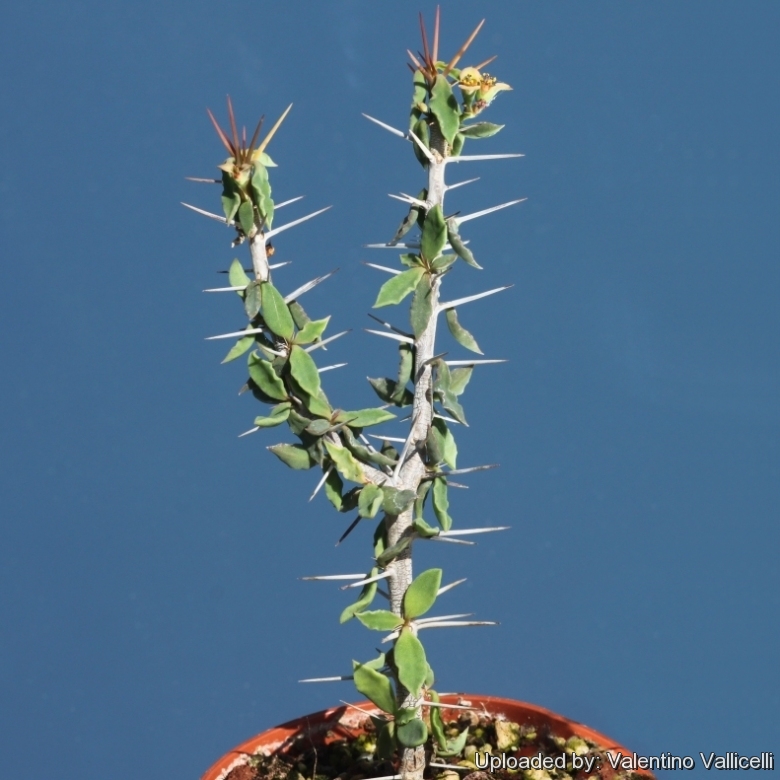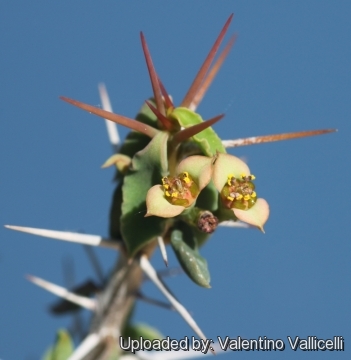Accepted Scientific Name: Euphorbia beharensis var. guillemetii (Ursch & Leandri) Rauh
Trop. Subtrop. Pflanzenwelt 100: 10 1999

Euphorbia guillemetii (Euphorbia beharensis var. guillemetii) Photo by: Valentino Vallicelli
Origin and Habitat: Euphorbia beharensisSN|31684]]SN|31684]] var. guillemetii is endemic to SE Madagascar (Fort-Dauphin area: Ranomainty, Amboasary). The area of occupancy calculated from the two only known collections is only 7.12 km².
Habitat and ecology: This variety occurs in dry bush. Euphorbia beharensisSN|31684]]SN|31684]] var. guillemetii is likely to have a very small extent of occurrence, and grows in a highly threatened habitat. Major threats comprise habitat degradation, fire, habitat clearing for charcoal and illegal collection for horticulture.
Synonyms:
See all synonyms of Euphorbia beharensis
Description: Euphorbia beharensisSN|31684]]SN|31684]] var. guillemetii (a.k.a. Euphorbia guillemetiiSN|31684]]SN|31686]]) is a sprawling shrublet with dark brow-green leaves that are sparsely arranged along the spiny branches. The cyathia (flowers) are small and dirty yellow. It is easily distinguished from Euphorbia beharensisSN|31686]]SN|31684]] by it shorter spines 3-8 mm long and longer leaves up to 12 mm long and 4 mm broad
Derivation of specific name: 'Guillemetii' Probably a spelling error for the French plant ecologist.Dr. Jean L. Guillaumet who discovered this plant near Ranomainty in southern Madagascar.
Stems. Euphorbia beharensisSN|31684]]SN|31684]] var. guillemetii has two kind of branches, the first kind are long, thin, cylindrical, branches also known as auxiblasts. These auxiblasts support numerous short-shoots also known as brachyblasts that are condensed branchlets produced in the leaf axils.
Leaves: Linear-lanceolate. Leaves of short-shoots 4 to 5, succulent, narrow-ovate, 7-12 mm long, 4 mm wide, apex acute, margin undulate
Stipular spines: short, 3-8 mm long.
Inflorescences: Stalk 1.5-2 cm long with 2 or more cyathia. Cyathophylls (coloured bracts around the cyathia) somewhat spreading, 6 mm long, 4 mm broad, yellow-green, apiculate. Nectar-glands reddish. Involucral bracts dentate, reddish. Ovary small, styles joined at the base, forked.
Subspecies, varieties, forms and cultivars of plants belonging to the Euphorbia beharensis group
- Euphorbia beharensis Leandri: is a much-branched shrubs with tuberous roots and branches very slender, 3-5 mm thick, spines 1-1.5 cm long. Inflorescence small green borne on short peduncle from branch apices. Distribution: S and SW Madagascar
- Euphorbia beharensis var. adpressifolia Rauh: has leaves deflexed against the stem. Cymes with very short peduncles. Distribution: SW Madagascar (Behara).
 Euphorbia beharensis var. guillemetii (Ursch & Leandri) Rauh: Has spines 3-8 mm long; leaves up to 12 mm long and 4 mm wide. Distribution: SW Madagascar (Ranomainty).
Euphorbia beharensis var. guillemetii (Ursch & Leandri) Rauh: Has spines 3-8 mm long; leaves up to 12 mm long and 4 mm wide. Distribution: SW Madagascar (Ranomainty).- Euphorbia beharensis var. squarrosa Rauh: has larger leaves up to 2 cm long; Spines shorter, to 5 mm long; Inflorescences on peduncles to 1.5 cm long; Cyathia smaller. Distribution: SW Madagascar(Tolanaro).
- Euphorbia beharensis var. truncata Rauh: has leaves obovate with truncate tips, to 1.5 cm long and 2 cm wide. Distribution: SW Madagascar (Tolanaro).
Bibliography: Major references and further lectures
1) Haevermans, T. 2004. Euphorbia beharensis var. guillemetii. The IUCN Red List of Threatened Species. Version 2015.2. <www.iucnredlist.org>. Downloaded on 09 August 2015.
2) Ursch, E. & Leandri, J. (1954) “Les Euphorbes malgaches épineuses et charnues du Jardin botanique de Tsimbàzaza.” Institut de recherches scientifiques de la République malgache , ser. B (Biologie végétale), Volume 5 : 109-185.
3) Werner Rauh, Herman Schwartz “Succulent and xerophytic plants of Madagascar” Volume 2 Strawberry Press, 1998
4) Urs Eggli, Leonard E. Newton “Etymological Dictionary of Succulent Plant Names” Springer Science & Business Media, 29 June 2013
 Euphorbia guillemetii (Euphorbia beharensis var. guillemetii) Photo by: Valentino Vallicelli
Euphorbia guillemetii (Euphorbia beharensis var. guillemetii) Photo by: Valentino VallicelliSend a photo of this plant.The gallery now contains thousands of pictures, however it is possible to do even more. We are, of course, seeking photos of species not yet shown in the gallery but not only that, we are also looking for better pictures than those already present.
Read More... Cultivation and Propagation: Euphorbia beharensis var. guillemetii is only likely to be found in specialist collections. Cultivation of this plant is the same as that for the other shrubby varieties of Euphorbia from tropical areas (Madagascar, and central Africa), but it is one the easiest.
Growth rate: It is a relatively fast growing species.
Exposure: Full sun to lit shade appears to be the optimum range, but can tolerate the most shade, and a plant that has been growing in shade should be slowly hardened off before placing it in full sun as the plant will be severely scorched if moved too suddenly from shade into sun.
Waterings: Relatively flexible in its watering requirements. They can be watered regularly as long as the medium is open and well drained. As with any normal plant when watering, it is best to do so thoroughly, until a little water comes out through the drain holes. Allow the medium to dry out somewhat between waterings. Reduce watering to once every 1 month during winter. Space plants apart to allow air movement between branches and leaves. This will help with evaporation of extra water droplets collected during watering.
Soil: The ideal potting-medium is one with good moisture-retaining capacity but open and well drained with some extra manure for added nutrition.
Fertilization: Regular fertilizing with low nitrogen and high phosphorus and potassium ratios are preferred. Feed during spring and summer to mid autumn and withhold feeding during winter.
Maintenance: Tall plant will benefit from being staked, with bamboo or other suitable stakes. In the absence of staking, the stems of the plants may snap under the weight.
Hardiness: Very tender, protect from frost. As the natural way they need in winter at least 12 to 15 °, with adequate irrigation but have no problems with it, to stand next to radiators.
Pest and diseases: Mildew can occur in high humidity.
Propagation: Cuttings It is recommend taking Euphorbia cuttings in Spring/Summer when the plant is growing so that they have a better chance of success. They key is heat & good air circulation. These cuttings should be dipped in Hormone powder (but it is not needed) and left for a period of 3-4 weeks to callous. Then pot the cutting and don't water ( or kept slightly moist) until rooted. These will root just fine, if you can put the pot outside in the summer, or put pot on a heating pad.
Warning: The milky sap produced by this shrub has been known to cause burning and blistering of the skin, and even temporary blindness, and death may result if any of its parts are eaten. All of these problems can be avoided if care is taken when handling the plant.












